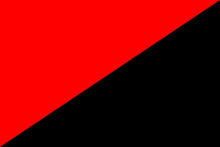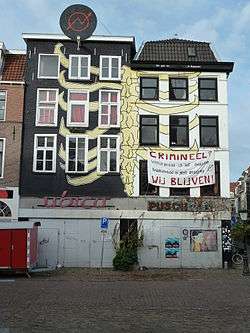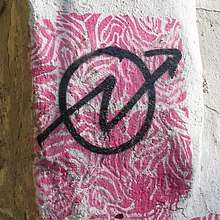Squatting
Squatting is the action of occupying an abandoned or unoccupied area of land or a building, usually residential, that the squatter does not own, rent or otherwise have lawful permission to use. Author Robert Neuwirth suggested in 2004 that there were one billion squatters globally.


Squatting occurs worldwide and tends to occur when people who are poor and homeless find empty buildings or land to occupy for housing. It has a long history, broken down by country below. In developing countries and least developed countries, shanty towns often begin as squatted settlements. There are pavement dwellers in India and South Africa, represented by groups such as Slum Dwellers International and Abahlali baseMjondolo. In Hong Kong there are rooftop slums. In Brazil, there are favelas and large social movements of thousands of people such as the Homeless Workers' Movement (MTST) and the Landless Workers' Movement (MST). Squatted settlements are known in Spanish-speaking countries under terms such as villa miseria (Argentina), pueblos jóvenes (Peru), okupas (Chile, Spain) and asentamientos irregulares (Guatemala, Uruguay).
In industrialized countries, there are often squats and also political squatting movements, which can be anarchist, autonomist, or socialist in nature. Oppositional movements from the 1960s and 1970s created freespaces such as Freetown Christiania in Denmark or Ruigoord in the Netherlands. Each local situation determines the context, for example in Italy there are self-managed social centres and in Athens, Greece, there are refugee squats. In England and Wales, there were estimated to be 50,000 squatters in the late 1970s.
Overview
The majority of squatting is residential in nature. Squatting tends to occur when a poor and homeless population sees derelict property or land.[1] According to author Robert Neuwirth, there were over 1 billion (one in seven) squatters worldwide in 2004. If current trends continue, this will increase to 2 billion by 2030 (one in four), and 3 billion by 2050 (one in three).[2] However, despite the numbers of people squatting, according to academic Kesia Reeve, "squatting is largely absent from policy and academic debate and is rarely conceptualised, as a problem, as a symptom, or as a social or housing movement."[3]
In many of the world's poorer countries, there are extensive slums or shanty towns, typically built on the edges of major cities and consisting almost entirely of self-constructed housing built without the landowner's permission.[4] While these settlements may, in time, grow to become both legalised and indistinguishable from normal residential neighbourhoods, they often start off as squats with minimal basic infrastructure. Thus, there is no sewerage system, drinking water must be bought from vendors or carried from a nearby tap, and if there is electricity, it is stolen from a passing cable. Such settlements also exist in industrialized countries, such as for example Cañada Real on the outskirts of Madrid.
Squatting can be related to political movements, such as anarchist, autonomist, or socialist. It can be a means to conserve buildings or a protest action. Squats can be used by local communities as free shops, cafés, venues, pirate radio stations or as multi-purpose autonomous social centres.[5]
Typology
Dutch sociologist Hans Pruijt separates types of squatters into five distinct categories:[5]
- Deprivation-based – homeless people squatting for housing need
- An alternative housing strategy – people unprepared to wait on municipal lists to be housed take direct action
- Entrepreneurial – people breaking into buildings to service the need of a community for cheap bars, clubs etc.
- Conservational – preserving monuments because the authorities have let them decay
- Political – activists squatting buildings as protests or to make social centres
Legality
In many countries, squatting is in itself a crime; in others, it is only seen as a civil conflict between the owner and the occupants. Property law and the state have traditionally favoured the property owner. However, in many cases where squatters had de facto ownership, laws have been changed to legitimize their status. Squatters often claim rights over the spaces they have squatted by virtue of occupation, rather than ownership; in this sense, squatting is similar to (and potentially a necessary condition of) adverse possession, by which a possessor of real property without title may eventually gain legal title to the real property.
Anarchist Colin Ward comments: "Squatting is the oldest mode of tenure in the world, and we are all descended from squatters. This is as true of the Queen [of the United Kingdom] with her 176,000 acres (710 km2) as it is of the 54 percent of householders in Britain who are owner-occupiers. They are all the ultimate recipients of stolen land, for to regard our planet as a commodity offends every conceivable principle of natural rights."[6]
Others have a different view. UK police official Sue Williams, for example, has stated that "Squatting is linked to anti-social behaviour and can cause a great deal of nuisance and distress to local residents. In some cases there may also be criminal activities involved."[7]
Perceptions
The public attitude toward squatting varies, depending on legal aspects, socioeconomic conditions, and the type of housing occupied by squatters. In particular, while squatting of municipal buildings may be treated leniently, squatting of private property often leads to strong negative reaction on the part of the public and authorities.[8] Squatting, when done in a positive and progressive manner, can be viewed as a way to reduce crime and vandalism to vacant properties, depending on the squatter's ability and willingness to conform to certain socioeconomic norms of the community in which they reside. Moreover, squatters can contribute to the maintenance or upgrading of sites that would otherwise be left unattended, the neglect of which would create (and has created) abandoned, dilapidated and decaying neighborhoods within certain sections of moderately to highly urbanized cities or boroughs, one such example being New York City's Lower Manhattan from roughly the 1970s to the post-9/11 era of the New Millennium.[9]
Adverse possession
Adverse possession, also known as squatter's rights, is a method of acquiring title to property through possession for a statutory period under certain conditions. Countries where this principle exists include England and the United States, based on common law. However, some non-common law jurisdictions have laws similar to adverse possession. For example, Louisiana has a legal doctrine called acquisitive prescription, which is derived from French law.
Africa
The Zabbaleen settlement and the City of the Dead are both well-known squatter communities in Cairo, Egypt.
There are large squatter communities in Kenya, such as Kibera in Nairobi.
An estimated 1,000 people live in the Grande Hotel Beira in Mozambique.
Informal settlements in Zambia, particularly around Lusaka, are known as kombonis.
South Africa
In South Africa, squatters tend to live in informal settlements or squatter camps on the outskirts of the larger cities, often but not always near townships. In the mid-1990s, an estimated 7.7 million South Africans lived in informal settlements: a fifth of the country's population.[10] The number has grown rapidly in the post-apartheid era. Many buildings, particularly in the inner city of Johannesburg have also been occupied by squatters. Property owners or government authorities can usually evict squatters after following certain legal procedures including requesting a court order.
In Durban, the city council routinely evicts without a court order in defiance of the law, and there has been sustained conflict between the city council and a shack dwellers' movement known as Abahlali baseMjondolo. The organisation has represented the squatters in land occupations such as the Macassar Village in 2009 and Marikana in 2013. It has also fought against the KZN Slums Act.
There have been a number of similar conflicts between shack dwellers, some linked with the Western Cape Anti-Eviction Campaign, and the city council in Cape Town. One of the most high-profile cases was the eviction of squatters in the N2 Gateway homes in the suburb of Delft, where over 20 residents were shot, including a three-year-old child. There have been numerous complaints about the legality of the government's actions.[11] Many of the families then squatted on Symphony Way, a main road in the township of Delft,before being forced to move to a camp called Blikkiesdorp.[12]
Asia
In China, informal settlements are known as urban villages.
Israeli settlements are communities of Israeli citizens living in the Palestinian territories. The international community considers the settlements in occupied territory to be illegal,[13][14] In March 2018, Israeli settlers were evicted from a house they had illegally occupied in Hebron, a Palestinian city in the West Bank. The fifteen families had argued that they had bought the house, but the High Court of Justice ruled that they had to leave. The Israel Defense Forces declared the building a closed military zone and it was unclear if the Palestinian owners could regain possession. The settlers had already occupied the house and been evicted in 2012.[15] In October 2018, Fatou Bensouda, the Chief Prosecutor of the International Criminal Court stated that Israel's planned demolition of Bedouin village Khan al-Ahmar could constitute a war crime.[16]
Squatters in Malaysia live on both privately owned and government-owned land.[17] Some squatters have lived on land owned by national electricity company Tenaga Nasional for over five decades.[18]
In Thailand, although evictions have reduced their visibility or numbers in urban areas, many squatters still occupy land near railroad tracks, under overpasses, and waterways. Commercial squatting is common in Thailand, where businesses temporarily seize nearby public real estate (such as sidewalks, roadsides, beaches, etc.) and roll out their enterprise, and at closing time they fold it in and lock it up, thus avoiding the extra cost of having to rent more property.[19]
India
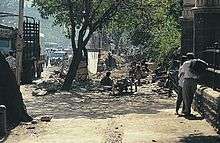
In Mumbai, there are an estimated 10 to 12 million inhabitants, and six million of them are squatters. The squatters live in a variety of ways. Some possess two- or three-story homes built out of brick and concrete which they have inhabited for years. Geeta Nagar is a squatter village based beside the Indian Navy compound at Colaba. Squatter Colony in Malad East has existed since 1962, and now, people living there pay a rent to the city council of 100 rupees a month. Dharavi is a community of one million squatters. The stores and factories situated there are mainly illegal and so are unregulated, but it is suggested that they do over $1 million in business every day.[20]
Other squatters are pavement dwellers, with very few possessions. Activists such as Jockin Arputham, Prema Gopalan and Sheela Patel are working for better living conditions for slum dwellers, through organisations such as Mahila Milan and Slum Dwellers International.
In the 2016 Mathura clash, members of Azad Bharat Vidhik Vaicharik Kranti Satyagrahi (Free India Legal Ideas Revolutionary Protesters) who had been living in Mathura's largest public park Jawahar Bagh for two years were evicted in a large police operation. At least 24 squatters were killed.[21]
Philippines
Squatting is a major issue in the Philippines especially but not exclusively in urban areas of the Philippines. Squatting gained notice right after World War II, when people whose homes were destroyed by war were left homeless. They built makeshift houses called "barong-barong" on abandoned private land.[22]
In the late 20th century, the squatter population largely grew but the Philippine government has made separate attempts over the years to transfer some squatters to low-cost housing projects, such as projects in Tondo (in the former Smokey Mountain landfill), Taguig (BLISS Housing Project), and Rodriguez, Rizal.
Philippine law, and society more generally, distinguishes between squatters who squat because of poverty and "professional squatters" who squat in hopes of getting a payment to leave the property.[23]
Philippine-based media and journalists refer to squatters as "informal settlers."[24][25]
Turkey
Gecekondu (plural gecekondular) is a Turkish word meaning a house put up quickly without proper permissions, a squatter's house, and by extension, a shanty or shack. Gecekondu bölgesi is a neighborhood made of these informal settlements. Shortly after the eviction of Gezi Park, Don Kişot (Quixote) was occupied and stated to be Istanbul's first occupied and self-managed social centre.[26] There are, or have been, several other political squats in İstanbul: Caferağa in Kadıköy was a squatted neighbourhood house evicted in December 2014.[27] "Caferağa brings life, people, and productivity into that old rotting house" said local Turan Yildirim.[28]
Elsewhere in Turkey, a place was occupied in Beşiktaş on March 18, 2014 and named Berkin Elvan Student House after a 15-year-old boy who was shot during the Gezi protests and later died.[29] Atopya[30] was squatted in Ankara in June 2014 by anarchists, who claimed it was the city's first political squat.[31]
Europe

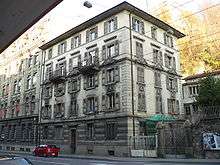
In many European countries, there are squatted houses used as residences and also larger squatted projects where people pursue social and cultural activities. An examples of the latter is a former military barracks called Metelkova in Slovenia.
Squat Milada in Prague, Czech Republic was occupied in 1997 and evicted in 2009. Its longevity was in part due to the building not existing in the Land Registry. Klinika was an occupied social centre between 2014 and 2019.
There was a big squatting movement in the newly formed state of Austria following the First World War. Famine was a significant problem for many people in Austria and the "Siedler" (settler) movement developed as these people tried to create shelter and a source of food for themselves.[32] The Ernst Kirchweger Haus (EKH) in Vienna was squatted as a social centre in 1990 and legalised in 2008. Nowadays from time to time empty buildings are squatted and in the most instances given up after negotiations with the authorities. There are some exceptions like in 2014, when about 1,500 riot police officers, a tank-like police vehicle, a police water cannon and helicopters have been used to clear a building occupied by the group "Pizzeria Anarchia" in Vienna.[33][34]
Christiania in Copenhagen, Denmark is an independent community of almost 900 people founded in 1971 on the site of an abandoned military zone. In Copenhagen, as in other European cities such as Berlin and Amsterdam, the squatter movement was large in the 1980s. It was a social movement, providing housing and alternative culture. A flashpoint came in 1986 with the Battle of Ryesgade. Another flashpoint came in 2007 when Ungdomshuset was evicted. While not technically a squat until 14 December 2006, it was a social centre used by squatters and people involved in alternative culture more generally. After a year of protests, the city council donated a new building.[35]
In early twentieth century France, several artists who would later become world-famous, such as Guillaume Apollinaire, Amedeo Modigliani and Pablo Picasso squatted at the Bateau-Lavoir, in Montmartre, Paris. Paris moved to legitimize some popular artist squats in the mid-2000s by purchasing and renovating the buildings for artist–residents.[36] An example is Les Frigos. In the 2010s there have been several land squats protesting against large infrastructure projects. These are known collectively as Zone to Defend or ZAD (French: zone à défendre), with the most famous one being the ZAD de Notre-Dame-des-Landes.
Starting from December 2012, Greek Police initiated extensive raids in a number of squats in Athens, arresting and charging with offences all illegal occupants (mostly anarchists). Squats including Villa Amalia were evicted.[37] A march in support of the 92 arrestees drew between 3,000 and 8,000 people.[38] After Villa Amalia, Villa Skaramanga and then Villa Lela Karagianni were evicted. Lela Karagianni had been squatted since 1998 and was later reoccupied.[39] The name came from the street, named for a Greek World War II resistance leader of that name. From 2015 onwards Athens has seen refugee squats in response to the European migrant crisis which are anarchist and self-organised.[40] In 2019, several squats in Exarcheia were evicted by the Greek state. Some of the migrants evicted set up a camp outside the Parliament at Syntagma Square.[41]
Squatting in Moldova started with Centro 73 in Chişinău in September 2010. This project was evicted soon after.[42]
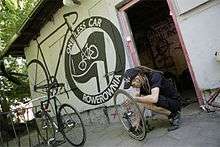
The oldest squat in Poland, Rozbrat, was created in 1994 in Poznań. There are also squats in Białystok, Gdańsk, Gliwice, Warsaw and Wrocław.[43]
Geneva in Switzerland had 160 buildings illegally occupied and more than 2,000 squatters, in the middle of the 1990s.[44] The RHINO (Retour des Habitants dans les Immeubles Non-Occupés, in English: Return of Inhabitants to Non-Occupied Buildings) was a 19-year-long squat in Geneva. It occupied two buildings on the Boulevard des Philosophes, a few blocks away from the main campus of the University of Geneva. The RHINO organisation often faced legal troubles, and Geneva police evicted the inhabitants on July 23, 2007.[44] There were large riots in Zürich when the Binz occupation was evicted in 2013. The squatters moved to another building.[45]
Germany
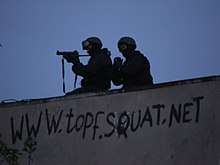
In the 1970s, squatting in West German cities led to "a self-confident urban counterculture with its own infrastructure of newspapers, self-managed collectives and housing cooperatives, feminist groups, and so on, which was prepared to intervene in local and broader politics".[46] The Autonomen movement protected squats against eviction and participated in radical direct action.
After the German reunification, many buildings were vacated due to the demise of former state-run enterprises and migration to the western parts of Germany, some of which were then occupied by squatters. In Berlin, the now-legalised squats are in desirable areas such as Mitte and Prenzlauer Berg. Before the reunification, squats in Berlin were mostly located in former West Berlin's borough of Kreuzberg. The squats were mainly for residential and social use. Squatting became known by the term instandbesetzen, from instandsetzen ("renovating") and besetzen ("occupying").[5]
Squatters moved into the former factory site of J.A. Topf & Söhne in Erfurt in April 2001 and remained there until they were evicted by police in April 2009. The firm made crematoria for Nazi concentration camps. The squatters ran culture programs which drew attention to the history of the company. The occupation was known simply as Das Besetzte Haus (the occupied house) and was one of the most well known actions of left-radicals of that period in Germany. A book about the occupation was published in 2012, titled Topf & Söhne – Besetzung auf einem Täterort (Topf & Söhne – Occupation of a crime scene).[47]
Despite being illegal, squats exist in many of the larger cities. Examples are Au in Frankfurt and Rote Flora in Hamburg, although the last open squat of Berlin, Brunnenstraße183, was evicted in November 2009. Legalised housing projects include Hafenstraße and Kiefernstraße.
Squatting can also take place for campaigning purposes, such as the Anatopia project, which protested against a Mercedes-Benz test track.
Iceland
.jpg)
In Reykjavík, the capital of Iceland, there is a small tradition of squatting. In 1919, anarchists occupied a building and were quickly evicted.[48]
Squatters occupied an empty house in downtown Reykjavík on Vatnsstigur street in April 2009.[49] The squatters set up a freeshop and had plans for a social centre, but the occupation was quickly evicted by the police and 22 people were arrested.[50]
Vatnsstigur 4 was briefly resquatted on May 7, 2009, in solidarity with the Rozbrat squat in Poland, which was threatened with eviction.[51]
Also in 2009, a group of graffiti artists called the Pretty Boys occupied Hverfisgata 34. Their intention was to make a clandestine gallery and then when they were not evicted, they legalised the space and called it Gallery Bosnia.[52]
When the Reykjavíkur Akademían (the Reykjavík Academy) was evicted at short notice from Hringbraut 121 in November 2011, it was occupied in protest. The space, which had hosted lectures and also Iceland's trade union and anarchist libraries, was moved to another location but the occupiers were unhappy that the new use of the building would be a guest house for tourists. An art exhibition was organised, with a camera obscura, live music and shadow theatre.[53]
Ireland
The exact legal position of squatting in Ireland is ambiguous and the mechanisms for removing squatters from properties varies from case to case, sometimes going through the judicial process, other times not. Trespass and occupation of a property is not illegal, but as a definitive process for dealing with squatters does not exist, unlawful evictions do occur,[54] sometimes with the support of the Garda Síochána (Irish Police).[55] However certain 'squatters rights' do exist and can be invoked in the form of adverse possession. An occupant is entitled to legal possession of the title provided they are in continuous and uninterrupted occupation of the property for 12 years.[56] To claim adverse possession the occupant must register an intent to claim the property with the land registry.
Squatting has no major tradition in Ireland, arguably in part due to the perceived strong position of the title holder. It has largely been confined to major cities but with the construction of Ghost estates across the country there has also been a rise in occupations of residential spaces in rural areas.[57] There have been major housing movements and periods of squatting in Ireland, including the activities of the Dublin and Derry Housing Action Committees of the late 1960s and early 1970s. Each had a militant campaign which participated in dozens or hundreds of actions and protests in demand of better housing conditions.[58] Many young people emigrated from Ireland in the 1980s and squatted in London.[59]
In 2003 activists calling themselves 'Autonomous Community Spaces' entered 'Disco Disco' in Dublin's Parnell Square to turn the space in a social centre. They were violently evicted 24 hours later.[60] From 2003 to 2004 the Magpie Squat was a residential space which housed activists in Dublin's Upper Leeson Street.[61] It is also where the first meeting was held for the opening of what would become Dublin's first autonomous social centre Seomra Spraoi.
Activists from Occupy Cork squatted a National Asset Management Agency (NAMA) building in Cork in 2010, with the intention of using it as a community resource centre. It was vacated shortly after the occupation.[62] With squatting becoming more public in the 2010s, Dublin hosted the 2014 'International Squatter Convergence', previously held in cities such as Dijon, Berlin and Brighton. Squatting also became popularised by the successful neighbourhood resistance to an attempted eviction of a large community used squatted space in Grangegorman in Dublin city in 2015.[63] The news of the eviction attempt and eventual successful resistance spread across social media[64] and international news.[65] The squatted complex enjoyed widespread support in the area and was also publicly supported by the city's Lord Mayor, Christy Burke[66] and by Irish Times journalist Una Mullally.[67] The building which once housed Neary's Hotel on Parnell St in Dublin's north inner city, was occupied in 2015 and renamed The Barricade Inn by squatters.[68] [69]
Italy
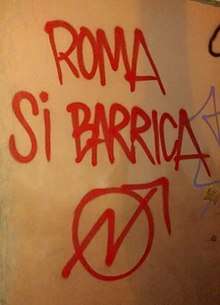
In Italy, despite the lack of official data, it appears that about 50,000 buildings all over the country are unused or abandoned and thus subject to squatting.[70] Squatting has no legal basis, but there are many squats used as social centres. The first occupations of abandoned buildings began in 1968 with the left-wing movements Lotta Continua and Potere Operaio. Out of the breakup of these two movements was born Autonomia Operaia, which was composed of a Marxist–Leninist and Maoist wing and also an anarchist and more libertarian one. These squats had Marxist-Leninist (but also Stalinist and Maoist) ideals and came from the left wing of Autonomia. The militants of the Italian armed struggle (the New Red Brigades) were connected to these squats.[71] There are many left-wing self-organised occupied projects across Italy such as Cascina Torchiera and Centro Sociale Leoncavallo in Milan and Forte Prenestino in Rome.
This situation has so far received the approval of Italian courts, which have been reluctant to defend the owners’ good reasons. In contrast with the dominant jurisprudence, new case-law (from the Rome Tribunal and the Supreme Court of Cassation) instructs the government to pay damages in case of squatting if the institutions have failed to prevent it.[72]
Netherlands

The Dutch use the term krakers to refer to people who squat houses with the aim of living in them (as opposed to people who break into buildings for the purpose of vandalism or theft).[5] Notable squats around the country include ACU and Moira in Utrecht, the Poortgebouw in Rotterdam, OCCII, OT301 and Vrankrijk in Amsterdam, the Grote Broek in Nijmegen, Vrijplaats Koppenhinksteeg in Leiden, De Vloek in the Hague and the Landbouwbelang in Maastricht.
On 1 June 2010, squatting in the Netherlands became illegal and punishable when a decree was sent out that the squatting ban would be enforced from 1 October.[73] In protest, squatters in Amsterdam had occupied a former fire department the week before the law began (returning it to the owners control on 30 September) and a riot occurred on 1 October when the police blocked a protest and led a horse charge upon it.[74] In Nijmegen (on 2 October), there was also a riot.[75][76] Following legal challenges, on October 28, 2011, the Supreme Court of the Netherlands decided that the eviction of a squat can only occur after an intervention of a judge.[77]
The Dutch government assessed the effectiveness of the new law in 2015, releasing a report giving statistics on arrests and convictions between October 2010 and December 2014. During this time period, 529 people have been arrested for the act of occupying derelict buildings in 213 separate incidents. Of the 529 arrests, 210 were found guilty. Of those convicted, 39 people were imprisoned for the new offence.[78]
Spain
Squatting of empty lots with shanty towns became popular in Spain in the 1960s and 1970s as a result of the shortage of urban accommodation during the rural exodus. Gradually it was substituted by high-rise blocks (often built quickly and poorly). It was revived in the mid-1980s during La Movida Madrileña, under the name of the okupa (an unofficial spelling applied to ocupación) movement, when thousands of illegal squatted buildings were legalized. Influenced by the British Levellers, the movement's popularity rose again during the 1990s, once more due to a housing crisis, this time related to the 1992 Summer Olympics and the concomitant urban regeneration. Property speculation and house price inflation continue to catalyze okupa activism.[79]
Okupa
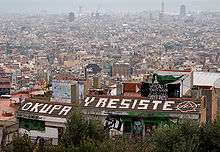
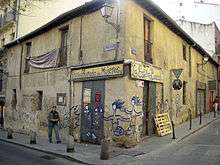
Related to the anarchist movement, okupas support the ideal of workers' self-management and create social centers, such as Patio Maravillas in Madrid, which carry out various grassroots activities. The okupa movement represents a highly politicized form of squatting, so much so that participants often claim they live in squats as a form of political protest first and foremost.[80] The movement is involved in various other social struggles, including the alter-globalization movement. In 1996, during José María Aznar's presidency, the first specific legislation against squatting was passed and became the prelude to many squat evictions. In the barrio of Lavapiés in Madrid, the Eskalera Karakola was a feminist self-managed squat, which was active from 1996 to 2005 and participated in the nextGENDERation network.[81] Other examples are the Escuela Popular de Prosperidad (La Prospe) o Minuesa.
As of 2007, there were approximately 200 occupied houses in Barcelona. At least 45 of these, as Infousurpa, a collective event calendar, mentions, are used as social and cultural centers – so-called "open houses".[82] A number of popular rock groups have come out of this kind of venue, such as Sin Dios, Extremoduro, Kolumna Durruti, Refugio and Platero y Tú in Madrid and Ojos de Brujo and Gadjo in Barcelona. In 2014, the unsuccessful attempts to evict the long-running social center of Can Vies provoked major riots.[83] Another long-running squat is Can Masdeu.
The Basque Country is another area where a high number of houses have been occupied. There are at least 46 squats, or gaztetxes ("youth houses" in Basque). During the 1980s, a house was occupied by squatters in virtually every town, with the booming Basque punk rock thriving on the squatting movement, as it provided the badly needed premises for concerts, exhibitions, and other events. During the last 10 years, at least 15 gaztetxes have closed down, often following protests and clashes with the police.[84] The eviction of Kukutza in Bilbao was met with largescale protests.[85] On the outskirts of Vitoria-Gasteiz, the squatted neighbourhood of Errekaleor has around 150 inhabitants.[86]
Chabolismo
Parallelly there has been a not-ideologized current of Chabolismo (shanty towns) around big cities. Initially settled by sedentarized Gitanos and Mercheros, they became known after the 1980s as selling points for heroin and other drugs. As the Spanish nomads were transferred to public housing, the shanty towns became inhabited by poor immigrants, including Moroccans and Romanian Romas. A famous example is the Cañada Real.[87][88][89][90]
 Kasa de la Muntanya, Barcelona-Vallcarca
Kasa de la Muntanya, Barcelona-Vallcarca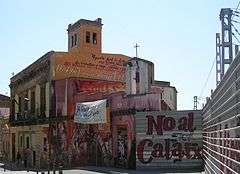 C.S.A. Can Vies, Barcelona-Sants
C.S.A. Can Vies, Barcelona-Sants Casa sense nom and Ateneu popular de l'Eixample, Barcelona-La Sagrada Familia
Casa sense nom and Ateneu popular de l'Eixample, Barcelona-La Sagrada Familia Ruïna Amàlia, Barcelona
Ruïna Amàlia, Barcelona Bahía, Barcelona-Sants
Bahía, Barcelona-Sants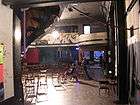 Bahía
Bahía- Can Masdeu, Barcelona-Collserola
United Kingdom

England
In England, squatting has a long historical tradition.[91] The BBC states that squatting was "a big issue in the Peasants' Revolt of 1381 and again for the Diggers in the 17th Century [who] were peasants who cultivated waste and common land, claiming it as their rightful due" and that squatting was a necessity after the Second World War when so many were homeless.[92] Mass squats were organised in a number of prominent public buildings in Central London, culminating in the occupation of the Queen Mother’s ex-residence at 144 Piccadilly in 1969 which became known as 'Hippydilly' and made world headline news[93] and the media created what one of the leaders later described as a moral panic. There were estimated to be 50,000 squatters throughout Britain in the late 1970s, with the majority (30,000) living in London.[94] The BBC reported in 2011 that the government estimated that there were "20,000 squatters in the UK" and "650,000 empty properties".[92]
On 1 September 2012, under Section 144 of the Legal Aid, Sentencing and Punishment of Offenders Act 2012, squatting in residential property was criminalised by the Government, punishable by up to six months in prison or a £5000 fine, or both.[95][96] The same year saw the first successful prosecution for squatting, resulting in a 12-week jail sentence.[97] However, squatting in a commercial building is still not a criminal offence.
Northern Ireland
In the late 1960s, people in Northern Ireland were forced to squat through both poverty and a lack of decent housing. In County Tyrone, there were allegations of unfair housing provision on the basis of politics and religion.[98] When a house in the village of Caledon, near Dungannon, was allocated to a young Protestant woman, Emily Beattie, it caused protests.[99] She was secretary to a solicitor who worked for the Unionist councillor who had given her the house and two Catholic families who had been overlooked complained that the same councillor had scotched plans to build houses for Catholics in the Dungannon area. Several days after the woman had moved in, the Catholic squatters in the house next door were evicted. Austin Currie, then a young politician, complained both at the local council and at Stormont about the situation. He then symbolically occupied the woman's house for a few hours, before being evicted by the Royal Ulster Constabulary (RUC). One of the policeman was the woman's brother who himself moved into the house later on.[98] The incident quickly became a media sensation and in August the civil rights movement arranged one of its first marches, from Coalisland to Dungannon. This was followed in October by a civil rights march in Derry which was organised by the Derry Housing Action Committee and the Northern Ireland Civil Rights Association. The march was brutally repressed by the RUC.[98]
In 2012 activists from Occupy Belfast squatted a Bank of Ireland building in Belfast city centre and used it as a social space.[100] The occupation lasted several months before it was evicted.
Scotland
Squatting is a criminal offence in Scotland, punishable by a fine or even imprisonment, under the Trespass (Scotland) Act 1865. The owner or lawful occupier of the property has the right to evict squatters without notice or applying to the court for an eviction order, although when evicting, they cannot do anything that would break the law, for example, use violence.[101] Nevertheless, the 19th and early 20th centuries saw various land raids in which cottars attempted to occupy land for subsistence farming. In 1948, the Seven Men of Knoydart unsuccessfully squatted land owned by the Nazi-supporting Lord Brocket.[102]
The Forest Café in Edinburgh squatted its old premises in 2011 before moving to a new site.[103]
There have been several road protest land squats such as Bilston Glen and Pollok Free State.[104][105]
Wales
In 2010, a representative of the UK Bailiff Company claimed that the number of people squatting in Wales was at its highest for 40 years.[106] The high number of businesses failing in urban Wales has led to squatting becoming a growing issue in large cities like Swansea and Cardiff.[107][108] Experts said "the majority [of squatters] are forced into the lifestyle by financial pressures." Based on the internal database of UK Bailiff Company, there were 100 cases of squatting in 2009, the highest for 40 years, following trends estimated by the Advisory Service for Squatters that squatting has doubled in England and Wales since 1995.[106]
As with England, from 1 September 2012, squatting in a residential building was made a criminal offence subject to arrest, fine and imprisonment.[109] In December 2012 Cardiff Squatters Network was formed, to network together squatters citywide, and host "skill-share" workshops on squatting legally in commercial buildings.[110]
North America
Canada
In Canada, there are two systems to register the ownership of land. Under the land title system, squatter rights, formally known as adverse possession, were abolished. However, under the registry system, these rights have been preserved. If a person occupies land for the required period of time as set out in provincial limitation acts and during that time no legal action is taken to evict them, then the ownership of the land transfers from the legal owner to the squatter.[111]
The Frances Street Squats in Vancouver were a row of six buildings squatted for nine months in 1990. They were evicted in a large operation and a film was subsequently made, called The Beat of Frances Street. In recent years, there have been a number of public squats which have brought together the two main contemporary reasons for squatting – homelessness and activism. Examples are the Lafontaine squat in Overdale, a district of Montréal (2001),[112] the Woodward's Squat in Vancouver (2002), the Infirmary Squat in Halifax (2002), the Pope Squat in Toronto (2002), the Seven Year Squat in Ottawa (2002), the Water Street Squat in Peterborough (2003), and the North Star hotel in Vancouver (2006). These were squats organised by anti-poverty groups which tended to have a short life expectancy.[113] The Woodward's building was a derelict department store which had stood empty for nine years. After being evicted from the building, two hundred squatters set up a tent city on the pavement outside.[114] The action is credited with putting in motion the eventual redevelopment of the building.[115] The Peterborough Coalition Against Poverty (PCAP) publicly squatted 1130 Water Street, a building which stood empty after a fire. The group offered to repair the place and return it to its use as low-income housing. City officials agreed to the repairs and then City Council voted to demolish the building. The cost of demolition was $8,900 and the cost of repairs had been projected to be $6,900.[113] The North Star hotel was temporarily squatted as a protest against emptiness by the Vancouver Anti-Poverty Committee.
In 2011, the 'Occupy Toronto squat team' squatted a basement at 238 Queen Street West and offered to take on a lease for 99 cents per year. They were evicted after eight hours.[116]
United States
| Squatting in the United States | ||||||
|---|---|---|---|---|---|---|
| International context | ||||||
| Legal acquisition | ||||||
|
||||||
| Housing and justice | ||||||
| Notable squats | ||||||

In the United States, squatting laws vary from state to state and city to city. For the most part, it is rarely tolerated to any degree for long, particularly in cities.[117] There have been a few exceptions, notably in 2002 when the New York City administration agreed to turn over eleven squatted buildings in the Lower East Side to an established non-profit group, on the condition the apartments would be turned over to the tenants as low-income housing cooperatives.[118]
Squatting in the US occurred during World War II when Japanese-Americans were sent to Manzanar, buildings around Little Tokyo area in Los Angeles were squatted by non-Japanese-American residents.[119]
Community organizations have helped the homeless to take over vacant buildings not only as a place to live but also a part of larger campaign to shine a light on inequity in housing and advocate change in housing and land issues.[120] Some of these include the Association of Community Organizations for Reform Now, Take Back the Land and Homes not Jails.
Squatters can be young people living in punk houses, low-income or homeless people, street gang members, or artists. During the Great Recession there were increasing numbers of people squatting foreclosed homes.[121][122] There were also reports of people resquatting their own foreclosed homes.[123]
South America
Around many South American cities there are shanty towns. Sometimes, the authorities tear the houses down, but often, the squatters simply rebuild again. The houses are built out of whatever material can be scavenged from the local area or bought cheaply. As time goes by, the squatters start to form communities and become more established. The houses are rebuilt piece by piece with more durable materials. In some cases, a deal is reached with the authorities and connections for sewage, drinking water, cable television and electricity are made.
In Peru, the name given to the squatter settlements is pueblos jóvenes. In Colombia and Venezuela they are called 'invasiones' (as in "invading a property", as squatting can be related to a building or an empty lot) and in Argentina they are known as villa miseria.
In Chile the correct term used for the squatting is the similar term used in Spain "Casa Okupa". These houses share similar aspects with other squats around the world, such as being political and activist social centres. They are normally associated with the anarchist movement and they openly identify with the squatting movement, particularly the Movimiento Okupa in Spain. The mayor number of Casas Okupas are located in Valparaíso and Santiago de Chile. They must not be confused with another different housing situation which term is Tomas. These are particular situations of squatting that could be defined more like Shanty Towns, not necessarily involved with the Okupa movement.
Brazil
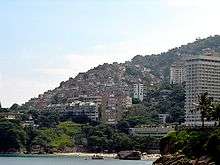
In Brazil, some of the squatter communities are called favelas, and a famous example is Rocinha in Rio de Janeiro, estimated to be home of 100,000 people. Favelas are mostly inhabited by the poorest strata, and usually lack much infrastructure and public services, but in some cases, already have reached the structure needed for a city. They are equivalent to slums or shanty towns, and typically occupy unused land (instead of unused or abandoned buildings). There were 25 million people living in favelas all over Brazil, as of 2004.[2]
In São Paulo the largest favela is Heliópolis, with over 200,000 inhabitants. However, its occupied area has been officially recognized as a regular neighborhood of the city. There are also a number of squatter buildings in the inner city, the most famous of which was a 22-storey building called Prestes Maia, whose inhabitants were finally evicted by the police in 2007 after a long conflict with the city administration. Inspired both by this movement and increasing property speculation and gentrification, various occupations in buildings and unoccupied areas in big cities, led by groups such as the Homeless Workers' Movement (MTST) or Downtown Roofless Movement (MSTC).[124]
The former Hotel Santos Dumont on Mauá Street in the Luz neighbourhood was occupied in 2007 after being derelict for 17 years. An estimated 1,000 people were living in the building, paying a small amount every month to cover maintenance. The community expels people who fight, use drugs or abuse alcohol.[125]
There are also rural squatter movements in Brazil, such as the Landless Workers' Movement (MST), which has an estimated 1.5 million members.
Oceania
Australia
In the 19th century, the British government claimed to own all of Australia and tried to control land ownership. Wealthy farmers of livestock claimed land for themselves and thus were known as squatters.[126] This type of squatting is covered in greater detail at Squatting (Australian history).
In more recent times, Australia has seen occupations in Canberra, Melbourne and Sydney. The Aboriginal Tent Embassy was set up in 1972 and is a permanent protest occupation. The 2016 Bendigo Street housing dispute saw squatters successfully contesting road-building plans. The Midnight Star squat was used as an self-managed social centre in a former cinema, before being evicted after being used as a convergence space during the 2002 World Trade Organization meeting.[127]
See also
References
- Peñalver, Eduardo M. (March 25, 2009). "Homesteaders in the Hood". Slate Magazine. Archived from the original on April 9, 2009. Retrieved April 17, 2009.
- Neuwirth, R. (2004), Shadow Cities: A Billion Squatters, A New Urban World, Routledge, ISBN 978-0-415-93319-3
- Reeve, Kesia (2005), "Squatting Since 1945: The enduring relevance of material need", in Somerville, Peter; Sprigings, Nigel (eds.), Housing and Social Policy, London: Routledge, pp. 197–216, ISBN 978-0-415-28366-3
- Encroachments and the Mystery of Capital. Political Economy – Development: Domestic Development Strategies eJournal. Social Science Research Network (SSRN). Accessed 16 April 2020.
- Pruijt, Hans (2011). "Logic of Urban Squatting". International Journal of Urban and Regional Research: 1–8. Archived from the original on 2016-03-05. Retrieved 2015-11-05.
- Wates, Nick; Wolmar, Christian (1980). Squatting: the Real Story. London: Bay Leaf Books. ISBN 0-9507259-0-0.
- "Statement from Detective Chief Superintendent Sue Williams, Borough Commander and Chair of the Community Safety Partnership" (Press release). London Borough of Redbridge. 2012-01-20. Archived from the original on 2012-05-16. Retrieved 2012-03-22.
- Elms, Robert (November 22, 2011). "Squatting: The need for shelter versus property rights". BBC. Archived from the original on November 17, 2018. Retrieved June 20, 2018.
- Srinivas, Hari. "Squatting: Defining Squatter Settlements". gdrc.org. Archived from the original on July 21, 2015. Retrieved July 30, 2015.
- Saff, Grant (1996). "Claiming a Space in a Changing South Africa: The 'Squatters' of Marconi Beam, Cape Town". Annals of the Association of American Geographers. 86 (2): 235–255. doi:10.1111/j.1467-8306.1996.tb01752.x. ISSN 0004-5608. JSTOR 2564004.
- "No compassion for people who do not drive a Porsche?". Constitutionally Speaking. Archived from the original on 2012-07-14. Retrieved 2019-04-30.
- Lali, Vincent (29 June 2018). "Blikkiesdorp residents frustrated by housing delays". Ground Up. Archived from the original on 30 April 2019. Retrieved 30 April 2019.
- Roberts, Adam (1990). "Prolonged Military Occupation: The Israeli-Occupied Territories Since 1967". The American Journal of International Law. American Society of International Law. 84 (1): 85–86. doi:10.2307/2203016. JSTOR 2203016. S2CID 145514740.
The international community has taken a critical view of both deportations and settlements as being contrary to international law.
- Pertile, Marco (2005). "'Legal Consequences of the Construction of a Wall in the Occupied Palestinian Territory': A Missed Opportunity for International Humanitarian Law?". In Conforti, Benedetto; Bravo, Luigi (eds.). The Italian Yearbook of International Law. 14. Martinus Nijhoff Publishers. p. 141. ISBN 978-90-04-15027-0.
the establishment of the Israeli settlements in the Occupied Palestinian Territory has been considered illegal by the international community and by the majority of legal scholars.
- Magid, Jacob (22 March 2018). "Settlers evacuate disputed Hebron building after squatting for 8 months". Times of Israel. Archived from the original on 26 May 2019. Retrieved 13 May 2019.
- TOI Staff (17 October 2018). "Hague prosecutor issues war crime warning on Bedouin village demolition". Times of Israel. Archived from the original on 25 May 2019. Retrieved 13 May 2019.
- Menon, Priya (12 August 2009). "Pasar Sentul squatters face an uncertain future". The Star. Archived from the original on 13 May 2019. Retrieved 13 May 2019.
- Menon, Priya (15 July 2009). "Sentul squatters want to escape urban squalor". The Star. Archived from the original on 13 May 2019. Retrieved 13 May 2019.
- Yasmeen, Gisèle; Narumol, Nirathron (2014). "Vending in Public Space: The Case of Bangkok" (PDF). WIEGO Policy Brief (16): 13–15. Archived from the original (PDF) on 20 April 2017. Retrieved 19 April 2017.
- Neuwirth, R (2004) Shadow Cities: A Billion Squatters, A New Urban World, pp. 110–14. Routledge ISBN 0-415-93319-6
- "India squatters: At least 24 killed in Mathura eviction drive". BBC. 3 June 2016. Archived from the original on 27 July 2019. Retrieved 27 July 2019.
- "Manila | national capital, Philippines". Encyclopedia Britannica. Archived from the original on 2017-01-18. Retrieved 2017-01-17.
- "Republic Act No. 7279 – An Act to Provide for a Comprehensive and Continuing Urban Development and Housing Program, Establish the Mechanism for its Implementation, and for Other Purposes". Article I, Republic Act No. 7279 of March 24, 1992. Chan Robles Law Library. Retrieved March 2, 2016.
- "From 'Squatters' Into 'Informal Settlers'". Philippine Human Rights Information Center. Pinyahan, Quezon City. September 6, 2014. Archived from the original on November 23, 2018. Retrieved March 2, 2016.
- Shahani, Lila Ramos (April 10, 2012). "Manila's biggest challenge". Views. Rappler. Oranbo, Pasig. Archived from the original on March 1, 2016. Retrieved March 2, 2016.
- "From Madrid to Istanbul: Occupying Public Space". ROAR Magazine. 2014-01-12. Archived from the original on 2016-09-24. Retrieved 2016-09-07.
- "Istanbul: Caferağa Mahalle Evi squatted community centre in Kadıköy evicted". squat.net. 2014-12-19. Archived from the original on 2016-09-19. Retrieved 2016-09-07.
- "Carrying on Gezi's Legacy, One House at a Time". Istanbul Project. 2014-08-22. Archived from the original on 2016-09-18. Retrieved 2016-09-07.
- ""Berkin Elvan Student House" Opens in Istanbul". BIA news desk. 2014-03-19. Archived from the original on 2016-09-15. Retrieved 2016-09-07.
- "Atopya project website". Archived from the original on 2016-07-29. Retrieved 2016-08-17.
- "Atopya: Ankara' da İşgal Evi". Sosyalsavas. 2014-05-24. Archived from the original on 2016-05-06. Retrieved 2016-08-17.
- Vossoughian, Nader (2008). Otto Neurath: The Language of the Global Polis. The Hague: NAi. ISBN 978-90-5662-350-0.
- "DerStandard.at". Archived from the original on 2018-12-09. Retrieved 2018-12-07.
- ""Pizzeria Anarchia": Räumung um 870.000 Euro". 2014-10-09. Archived from the original on 2018-12-09. Retrieved 2018-12-07.
- "Aktivister har overtaget nyt ungdomshus" (in Danish). Politiken. 2008-06-30. Archived from the original on 2008-08-03. Retrieved 2008-06-30.
- Pfeiffer, Alice (January 26, 2010). "Artists' Squats in Paris". The New York Times. ISSN 0362-4331. Archived from the original on July 29, 2017. Retrieved September 9, 2017.
- "Στον ανακριτή ανά ομάδες οι 92 συλληφθέντες από τη βίλα Αμαλίας". in.gr. January 10, 2013. Archived from the original on January 13, 2013. Retrieved 2013-01-10.
- Dabilis, Andy (12 January 2013). "Anarchists Rally Supports Squatters Rights". Archived from the original on 20 April 2019. Retrieved 20 April 2019.
- Cappuccini, Monia (2017). Austerity & Democracy in Athens: Crisis and Community in Exarchia. Palgrave Macmillan. p. 52. ISBN 9783319641270.
- Maniatis, Giorgos (October 2018). "From a Crisis of Management to Humanitarian Crisis Management". South Atlantic Quarterly. 117 (4): 905–913. doi:10.1215/00382876-7166068. ISSN 0038-2876.
- "Refugees evicted from squat set up camp in Syntagma". Ekathimerini. 20 April 2019. Archived from the original on 25 May 2019. Retrieved 19 May 2019.
- "multimedia | centro 73 chişinău". Centro 73. 2010-10-07. Archived from the original on 2010-12-11. Retrieved 2010-11-27.
- Piotrowski, Grzegorz (2014). "Squatting in the East: The Rozbrat squat in Poland, 1994 – 2012". In Katzeff, Ask; van Hoogenhuijze, Leendert; van der Steen, Bart (eds.). The City Is Ours: Squatting and Autonomous Movements in Europe from the 1970s to the Present. PM Press. ISBN 978-1604866834.
- Swissinfo (2007-07-23). "Geneva's historic Rhino squat evicted". Swissinfo. Archived from the original on 2019-03-27. Retrieved 2019-03-26.
- Feusi, Alois (31 May 2013). "Die Binz-Besetzer sind abgezogen". Neue Zürcher Zeitung. Archived from the original on 20 December 2016. Retrieved 6 December 2016.
- Mayer M The Career of Urban Social Movements in West Germany in eds Fisher R and Kling J Urban Affairs Annual Review volume 41 London (1993)
- Meyerbeer, Karl; Späth, Pascal (eds) (2012) Topf & Söhne – Besetzung auf einem Täterort. Heidelberg: Graswurzel-Verlag
- Grettisson, Valur (20 April 2017). "Reykjavík Of Yore: Squatting, And The Total Failure of Zoning". Reykjavík Grapevine. Archived from the original on 12 April 2019. Retrieved 12 April 2019.
- Fontaine, Paul (15 April 2009). "Squatters Take Over Downtown House". Reykjavík Grapevine. Archived from the original on 13 April 2019. Retrieved 12 April 2019.
- Fulton, Catharine (April 15, 2009). "Allir á Vatnsstíg, löggan er komin". Reykjavík Grapevine. Archived from the original on 13 April 2019. Retrieved 13 April 2019.
- Fulton, Catharine (7 May 2009). "We're persistent bastards!". Reykjavík Grapevine. Archived from the original on 13 April 2019. Retrieved 13 April 2019.
- Beckett, RX (17 November 2009). "Refilling 101". Reykjavík Grapevine. Archived from the original on 13 April 2019. Retrieved 13 April 2019.
- Benjamin, Gabríel (3 November 2014). "The New Political Squat In Town". Reykjavík Grapevine. Archived from the original on 13 April 2019. Retrieved 13 April 2019.
- "Three men sentenced over forced eviction for landlord". Irish Times. Archived from the original on 2015-07-05. Retrieved 2015-02-06.
- Fedayn. "Grangegorman resists eviction". Rabble. Archived from the original on 2015-03-28. Retrieved 2015-02-06.
- Independent Woman (2007-09-19). "Squatters' rights to be reviewed – Property, Unsorted". Independent.ie. Archived from the original on 2012-02-19. Retrieved 2012-02-20.
- Claire O'Brien (2011-10-15). "Squatter told he can stay in NAMA ghost estate home – National News". Independent.ie. Archived from the original on 2012-02-19. Retrieved 2012-02-20.
- Anarchist Writers. "The hidden history of squatting in Ireland". Struggle.ws. Archived from the original on 2018-06-05. Retrieved 2015-02-06.
- Lalor, Francesca (25 April 2019). "The Squat Generation: Documentary On Newstalk". Newstalk. Retrieved 14 June 2020.
- "Pictures of attack on Squat". Ireland: Ie.indymedia.org. Archived from the original on 2015-05-02. Retrieved 2014-05-20.
- "Squatting in Dublin : Housing is a Right not a Luxury". Struggle.ws. Archived from the original on 2013-11-02. Retrieved 2014-05-20.
- "Cork City Centre: Community Resource Center | Official Webpage". Corkcitycentre.wordpress.com. 2012-01-08. Archived from the original on 2014-05-20. Retrieved 2014-05-20.
- Dan Griffin. "Squatter Supporters hurt in Grangegorman stand off". Irish Times. Archived from the original on 2015-07-06. Retrieved 2015-01-06.
- Aoife Barry. "Grangegorman squatters welcome "victory" as they resist eviction". The Journal. Archived from the original on 2015-03-25. Retrieved 2015-01-06.
- "Residents resist eviction, clash with police in Dublin suburb". Al Jazeera. Archived from the original on 2015-03-26. Retrieved 2015-01-06.
- "Lord Mayor Praises Squatters Work". Irish Independent. Archived from the original on 2015-06-02. Retrieved 2015-01-06.
- Una Mullally. "The Grangegorman Squat". Irish Times. Archived from the original on 2015-03-24. Retrieved 2015-01-06.
- Squat Radar. "Barricade Inn". Squat Radar. Archived from the original on 2016-02-05. Retrieved 2015-02-06.
- Sylvia Thompson (2015-10-29). "Squatters bring life to old buildings". Irish Times. Archived from the original on 2015-10-30. Retrieved 2015-11-06.
- Giuseppe Portonera. International Property Rights Alliance (ed.). "The Problem of Squatting in Italy: A New Approach by the Courts". IPRI 2019. p. 1. SSRN 3472293.
- Wright, Steve (2002-02-20). Storming Heaven: Class Composition and Struggle in Italian Autonomous Marxism. Pluto. ISBN 978-0745316062. Archived from the original on 2015-10-12. Retrieved 2015-11-06.
- Giuseppe Portonera. International Property Rights Alliance (ed.). "The Problem of Squatting in Italy: A New Approach by the Courts". IPRI 2019. pp. 5–11. SSRN 3472293.
- "Eerste Kamer neemt antikraakwet aan – Binnenland". Volkskrant.nl. Archived from the original on 2010-06-04. Retrieved 2010-10-02.
- "Indymedia Netherlands Squat Ban Riot". Indymedia.org.uk. Archived from the original on 2012-02-25. Retrieved 2012-02-20.
- "whatever.squat.net". whatever.squat.net. Archived from the original on 2012-03-13. Retrieved 2012-02-20.
- "Squatters demo in Nijmegen". YouTube. 2010-10-02. Archived from the original on 2012-08-25. Retrieved 2010-11-25.
- Dee, E.T.C. (2016). "The Production of Squatters as Folk Devils: Analysis of a Moral Panic that Facilitated the Criminalization of Squatting in the Netherlands". Deviant Behavior. 37 (7): 784–794. doi:10.1080/01639625.2016.1145019. S2CID 147421606.
- "The vacancy crunch: The current housing crisis in the Netherlands and the repression of squatting". CNS Blog. 2016-05-14. Archived from the original on 2016-09-16. Retrieved 2016-09-07.
- Games Monitor. "The 'success' of Barcelona". Gamesmonitor.org.uk. Archived from the original on 2012-02-24. Retrieved 2012-02-20.
- "CASA Participants 2005". Casa.manifestor.org. Archived from the original on 2016-03-10. Retrieved 2012-02-20.
- "nextGENDERation network". Nextgenderation.net. Archived from the original on 2012-02-07. Retrieved 2012-02-20.
- Infousurpa – Butlleti setmanal de contr@informació des del 1996. Nr. 486, 11 to 17 July 2007 (collective, weekly updated event calendar of 45 occupied houses in Barcelona; hanging out in occupied houses)
- Govan, Fiona (2014-05-30). "Squat demolition called off after four nights of rioting in Barcelona". The Telegraph. Archived from the original on 1 June 2014. Retrieved 1 June 2014.
- Desalojo del gaztetxe Euskal Jai en Iruña on YouTube
- "The Basque Country And A Peace Process That Spain Is Ignoring". AN SIONNACH FIONN. Ireland. 2011-09-26. Archived from the original on 2019-04-03. Retrieved 2019-04-03.
- Azumendi, Eduardo (16 October 2019). "El barrio 'okupa' de Errekaleor: "Nos han quitado la luz, pero tenemos más energía que nunca"". Archived from the original on 16 June 2019. Retrieved 18 June 2019.
En total, 150, en lo que constituye una de las áreas urbanas ocupadas más grandes de España.
- ¿Ilegales para siempre?., Javier Lafuente, El País, 19 March 2008.
- De camino de ovejas a foco de marginalidad Archived 2010-10-31 at the Wayback Machine, José Luis Martín, El Mundo, 3 June 2004
- La Cañada Real, foco de delincuencia y venta de droga Archived 2010-04-06 at the Wayback Machine, El Mundo, 18/10/2007.
- Unos 200 vecinos de la Cañada Real Galiana protestan contra el desalojo de ayer con una marcha por la A-3. Archived 2008-06-22 at the Wayback Machine, Público, 19/10/2007.
- "Squatting in England: Heritage & Prospects". Crimethinc. Crimethinc. 13 May 2014. Archived from the original on 20 September 2016. Retrieved 9 September 2016.
- Squatters: Who are they and why do they squat? Archived 2019-05-13 at the Wayback Machine, BBC
- Issimdar, Mariam (2019-10-05). "When hippy squatters took over 144 Piccadilly". BBC News. Retrieved 2020-04-02.
- Kearns, K (1979). "Intraurban Squatting in London". Annals of the Association of American Geographers. 69 (4): 589–598. doi:10.1111/j.1467-8306.1979.tb01284.x.
- "Squatting set to become a criminal offence". BBC News. 31 August 2012. Archived from the original on 20 September 2019. Retrieved 20 June 2018.
- "Ministry of Justice Circular No. 2012/04 – Offence of Squatting In a Residential Building" (PDF). Archived (PDF) from the original on 2013-01-16. Retrieved 2013-01-09.
- "First person jailed for squatting". BBC News. 2012-09-27. Archived from the original on 2018-11-05. Retrieved 2018-11-05.
- McKittrick, David; McVea, David (2000). Making Sense of the Troubles (Third, 2012 ed.). Penguin. ISBN 9780241-962657.
- Clarke, Liam (21 December 2015). "Lord Kilclooney: 'I'm impressed by Martin McGuinnness' development'". Belfast Telegraph. Archived from the original on 7 June 2019. Retrieved 10 September 2019.
- McDonald, Henry (2012-01-16). "Occupy protesters take over former bank in Belfast". The Guardian. Archived from the original on 2015-06-02. Retrieved 2015-02-06.
- "Squatting". Scotland.shelter.org.uk. 2010-07-23. Archived from the original on 2011-09-03. Retrieved 2012-02-20.
- Scott, A. (2015). Native Stranger: A Journey in Familiar and Foreign Scotland. Hachette UK. ISBN 978-0751561227. Retrieved 10 August 2019.
- "Protesters stage sit-in at community arts centre | News | Edinburgh | STV". Local.stv.tv. 1 December 2011. Archived from the original on 3 January 2012. Retrieved 28 November 2012.
- "Man dies in fire at Bilston Glen protest camp". BBC. 31 January 2011. Archived from the original on 7 April 2019. Retrieved 6 April 2019.
- "Pollok Free State Lives On!". Do or Die No.5. 1995. Archived from the original on 2019-08-01. Retrieved 2019-04-07.
- Malone, Sam (2010-09-05). "Rise in squatters puts more Welsh homeowners at risk of huge eviction bills". Walesonline.co.uk. Archived from the original on 2011-09-10. Retrieved 2012-02-20.
- "Cwtch community group occupies Swansea's empty Dolphin Hotel". BBC News. January 31, 2012. Archived from the original on November 20, 2018. Retrieved June 20, 2018.
- "WRU bosses vow to fight Occupy Cardiff squatters". Wales Online. November 29, 2011. Archived from the original on January 19, 2012. Retrieved February 29, 2012.
- "Squatting set to become a criminal offence". BBC News. 2012-08-31. Archived from the original on 2019-09-20. Retrieved 2018-06-20.
- "Squatters form Cardiff-wide network". Wales Online. December 11, 2012. Archived from the original on December 15, 2012. Retrieved December 11, 2012.
- "Adverse Possession – The Law Behind Land Squatters". Archived from the original on 2012-01-06. Retrieved 2012-01-10.
- Hanes, A. 'Squatters still going strong: Overdale activists vow never to leave new homes at city-owned Centre Prefontaine' in The Montréal Gazette August 23, 2001
- "Labour Battles in B.C. and Quebec – Canadian Dimension". Archived from the original on 2008-10-07. Retrieved 2013-01-12.
- Vancouver's Woodwards squatters must go by Monday Archived 2006-05-24 at the Wayback Machine
- Ward, D. 'Anti-Olympic protesters get their game on' The Vancouver Sun January 29, 2010
- Sweetman, M. 'Occupying housing from the Pope Squat to Occupy Toronto' Archived 2013-03-13 at the Wayback Machine December 19, 2011
- Romero, Roberta (2008-09-26), City moves to evict homeless campers, KING 5 TV, archived from the original on 2008-09-27, retrieved 2008-09-26
- Ferguson, Sarah (August 27, 2002), "Better Homes and Squatters: New York's Outlaw Homesteaders Earn the Right to Stay", The Village Voice, archived from the original on June 29, 2011, retrieved July 17, 2009
- Nakagawa, Martha. "Little Tokyo / Bronzeville, Los Angeles" Densho Encyclopedia. Retrieved July 29, 2020.
- Amy Starecheski (2016). Ours to Lose: When Squatters Became Homeowners in New York City. University of Chicago Press. ISBN 9780226400006.
- Netter, Sarah (2010-08-23), "Anti-Government Sovereign Citizens Taking Foreclosed Homes Using Phony Deeds, Authorities Say", ABC NEWS, archived from the original on 2011-09-06, retrieved 2011-05-24
- Bernstein, Maxine (2011-04-22), "A homeowner startled to find squatter living in the Portland house he bought out of foreclosure", The Oregonian, archived from the original on 2011-05-27, retrieved 2011-05-24
- Roberts, Chris (2011-05-20), "After Foreclosure, Woman Breaks Back into, Squats", NBC, archived from the original on 2012-04-02, retrieved 2011-05-24
- Phillips, Tom (23 January 2006). "Brazil's roofless reclaim the cities". Guardian. Archived from the original on 14 April 2019. Retrieved 14 April 2019.
- Phillips, Dom (30 September 2017). "Driven by poverty, squatters occupied a derelict São Paulo hotel. Now they face eviction". Guardian. Archived from the original on 13 April 2019. Retrieved 14 April 2019.
- "The squattocracy". State Library of Victoria. Archived from the original on 14 May 2019. Retrieved 14 May 2019.
- Berry, Vanessa (2016). "The Excess and Potential of the Movie Theatre Ruin: The Midnight Star" (PDF). Transformations (28). Archived (PDF) from the original on 21 April 2018. Retrieved 14 May 2019.
Further reading
- Bailey, R. (1973) The Squatters Penguin: UK ISBN 0140523006
- Corr, A. (1999) No Trespassing! Squatting, Rent Strikes and Land Struggles Worldwide South End Press ISBN 0-89608-595-3
- ADILKNO (1994) Cracking The Movement – Amsterdam squatter history and the movement's relation to the media. Also available online
- Cracking The System (2008) – A zine about squats and social centres in Europe inspired by the april2008 initiative. Also available online.
- Curtis, H. & Sanderson, M. (2004) The Unsung Sixties Whiting & Birch ISBN 1861770448
- Dobbz, H. (2013) Nine-Tenths of the Law: Property and Resistance in the United States AK Press ISBN 978-184935118-8
- Kadir, Nazima (2016). The Autonomous Life?: Paradoxes of Hierarchy and Authority in the Squatters Movement in Amsterdam (Reprint ed.). Manchester: Manchester University Press. ISBN 978-1-78499-411-2.
- Katsiaficas, G. (1999) The Subversion of Politics: European Autonomous Social Movements and the Decolonization of Everyday Life Humanity Books ISBN 1-57392-441-5 Also available online
- Owens, L. (2009) Cracking the Movement: Narrating the Decline of the Amsterdam Squatters' Movement ISBN 9780271034638
- Schmid, L. (2014) Häuserkampf im Berlin der 1980er Jahre: Squatting in Berlin in the 1980s ISBN 978-3863681098
- Squatting Europe Kollective (2013) Squatting in Europe: Radical Spaces Urban, Struggles Minor Compositions ISBN 978-1-57027-257-8 Also available as a free PDF
- Squatting Everywhere Kollective (2018) Fighting for spaces, Fighting for our lives: Squatting movements today ISBN 978-3-942885-90-4
- Tobocman, S. (reissued 2016) War in the Neighborhood New York: Autonomedia – a graphic novel about squatting on New York City's Lower East Side in the 1980s
- Vasudevan, A. (2017). The Autonomous City: A History of Urban Squatting. Verso Books. ISBN 978-1-78168-787-1.
- Waterhouse, R. (2005) The Vision Splendid: A Social and Cultural History of Rural Australia, Fremantle, Curtain University Books
- Wittger, B. (2017) Squatting in Rio de Janeiro : constructing citizenship and gender from below Transcript-Verlag ISBN 9783837635478
External links
| Wikimedia Commons has media related to Squatting. |

